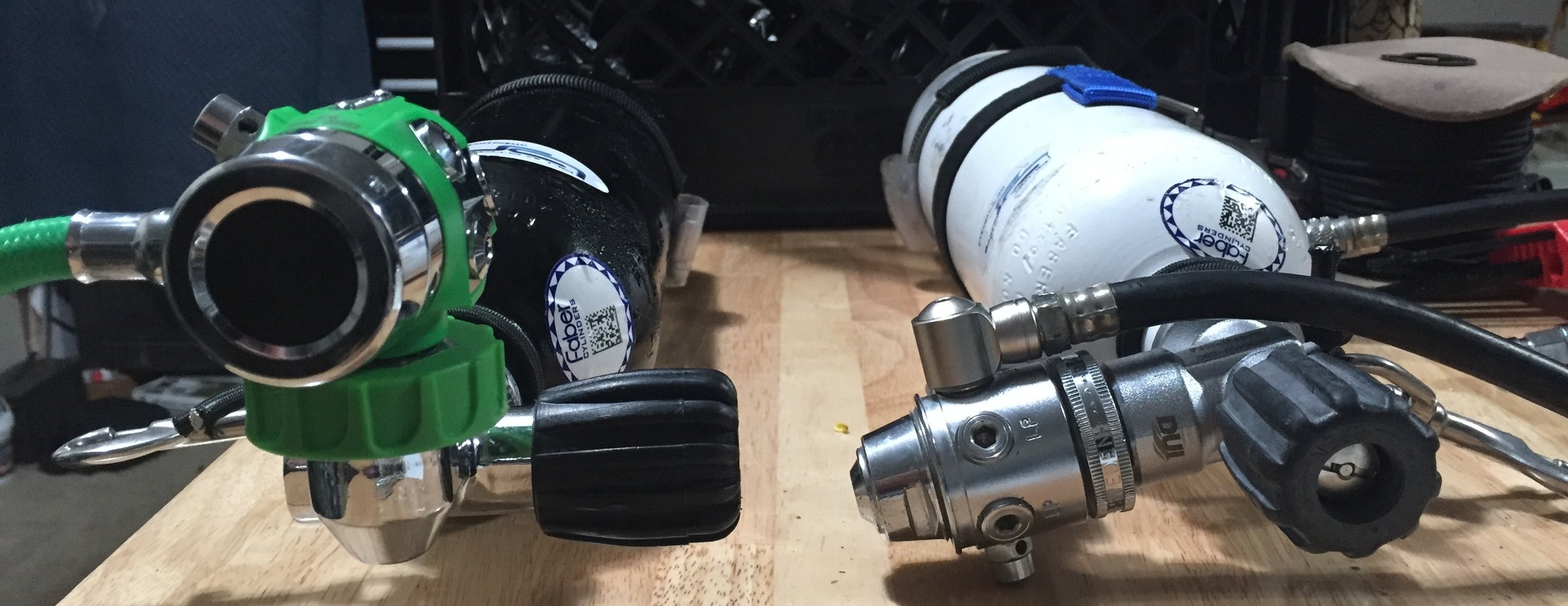Never happy to remain with the factory option, (or according to Chrissy: "Why does everything you own look like you built it in the garage?) I have been piddling with finding the optimal Oxygen valve and regulator setup for the KISS sidewinder.
The factory setup is a standard left handed valve and high quality first stage with fixed intermediate pressure. Weight: 2 pounds and 10 ounces.
I have a few problems with the factory setup that are particular to my usage- it sticks up a little too high for my tastes (actually catches on things in small spaces laying on my legs); It is too heavy on one end, requiring a counterweight on the opposite shoulder, and I don't want a fixed intermediate pressure regulator, as I am using an adjustable needle valve.
The H2Odyssey valve/regulator combo, courtesy of Mike Young.
My first stop was to try out one of the slick H2Odyssey valve and first stage combos, which weighed in at almost a pound less than the standard setup. It didn't completely eliminate the need for a counterweight, but reduced the size of it significantly. It took a few weeks, but the first problem stood out immediately- the fill port. This thing fills like a spare air- in that it requires an adapter. And the adapter is no magical piece of machining. It leaks frequently, and the drain sleeve is difficult to close tight enough to prevent leaks. Probably the most troublesome part of the fill process is the existence of a one-way valve in the fill port. It is so tight that the pressure must rise about 300 PSI higher than your final pressure for it to open. Very problematic when filling with a booster, trying to get to 3000 PSI. Frequently the booster hit 3300-3500 each stroke to settle at 2900 in the bottle. Once in the water, it worked fairly well, the low profile was quite nice, right until the bottle valve required manipulating. when pressurized, the little red cross became difficult to turn. The small size and low clearance was difficult with bare hands behind your back, and would have been nearly impossible with gloves in cold water.
DUI suit bottle valve and Poseidon first stage.
For the next iteration I got ideas from several people, but Kyle Moschell (KUR) put me on to this beautiful DUI top handled valve, a design I had been looking for for many years for other uses, and I had no idea existed. I bought a couple of them. The 1st stage is a hand me down from my Canadian friend and sump diver Peter Norris. The standard valve weighs in at 1 lb, 6 oz, and the DUI valve weighs in at 1 lb, 4 3/8 ounces, so the weight loss is split between the smaller valve and the smaller first stage. At first, it looks a little awkward, but the valves are ultimately the same length, from the top of the bottle to the furthest point from the bottle.
In this picture, the black tank setup is upside down, the regulator rides on the low side of the tank ideally, hanging off the edge of your leg, as shown on Edd Sorrensen, below:
Edd with his sidewinder, courtesy of the KISS website.
This works pretty well, but puts the O2 valve in an awkward position for manipulation, as it is a difficult reach far behind you with the scrubber canisters directly behind your arms and the handle pointed away from you. This causes many to add an inline shutoff valve on the oxygen line instead of trying to reach the valve. The DUI valve makes the knob much easier to reach, as your hand falls to it naturally, about where your aft tank connection point is located. It does not stick far enough out to be rubbed closed from any direction, save in a situation where you might have the right tank removed. From this vantage point you can see that the entire valve and regulator (even with swivel) are lower profile than the thickness of the bottle when worn in this configuration.
Another view shows that the DUI valve could be arranged without the low pressure swivel in the same fashion as the factory setup, and the valve would still be much easier to reach, however I prefer the lower profile setup as shown. On a side note, I'm not a complete fan of the digital sender, I find the information it provides pretty much what I would expect at the end of the dive, though on longer dives, it is nice to have some warning of when an O2 source switch is coming due, as this rebreather does not have on board redundant oxygen.
That's it for this installment of This old Rebreather, stay tuned for more fiddling and bad ideas!





